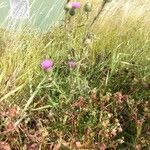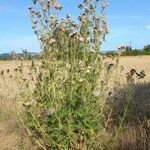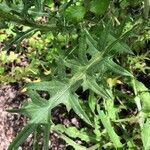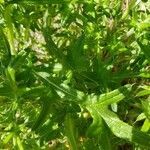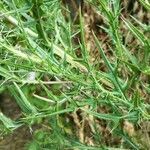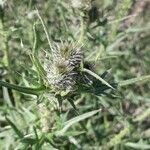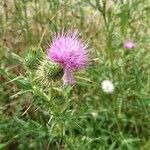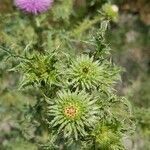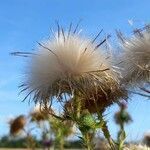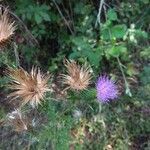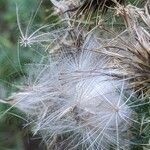Herbs 25-150 cm tall, biennial. Stems grayish white, erect, branched above, winged, with sparse long multicellular hairs and cobwebby, densely felted above; wings toothed, teeth ending in a long spine. Leaves herbaceous, discolorous, abaxially grayish white and densely felted, adaxially green to yellowish green, rough and densely covered with ca. 1.5 mm spinules. Middle cauline leaves sessile, linear-lanceolate, lanceolate, or oblanceolate, 10-15 × 4-5 cm, bipinnatipartite; primary segments 3 or 4 pairs, equally or unequally forked; secondary segments triangular to lanceolate, fringed with spinules, apex with a 5-10 mm spine; terminal lobe lanceolate, fringed with spinules and a few spines 5-10 mm. Upper cauline leaves similar but gradually smaller upward. Bracts linear, margin with long spines. Capitula few to many, paniculate-corymbose to racemose, erect. Involucre ovoid, 3-5 cm in diam., glabrous. Phyllaries imbricate, in ca. 10 rows, lacking wings and scarious appendage; outer and middle phyllaries 0.8-3 × 0.2-0.4 cm, basal portion triangular, lanceolate, or linear, apical portion subulate, 5-9 mm, and narrowed into a spine; inner phyllaries linear, ca. 3.4 × 0.3 cm, apex acuminate. Florets bisexual. Corolla red, ca. 3 cm, tube filiform, ca. 2 cm. Achene brown, ca. 4 mm. Pappus bristles white, to 3 cm. Fl. and fr. Jul-Aug. 2n = 34, 68.
Taprooted biennial. Stems branched, with soft multicellular and fine cobwebby hairs, (20)-50-150-(200) cm tall, ribbed, with broad, dentate, spiny wings between lf bases. Lvs oblanceolate or narrowly oblanceolate, deeply pinnatifid (subentire to shallowly pinnatifid in seedlings), dark green above, paler beneath, (7)-10-30-(40) × 4-10-(20) cm, with short, stiff, pale, spinous bristles above and dense cobwebby tomentum beneath; lf lobes deltoid to lanceolate to linear; prickles pale, 4-10 mm long. Subfloral lvs linear, short to long, sometimes investing capitula. Capitula ovoid, waisted at flowering, erect, 2.5-6 × 2.5-5 cm, solitary or in clusters of 2-3; peduncles 0-2 cm long. Outer involucral bracts linear, with cobwebby margins; apex acuminate, with strong spine 3-4-(6) mm long, recurved to patent. Inner involucral bracts linear, becoming ciliate; apex acute, not spinous, erect. Corolla purple, 28-33 mm long; lobes 5-6 mm long. Style exserted c. 3 mm beyond corolla lobes. Achenes pale, narrowly obovoid, c. 4 × 1.5 mm; pappus 20-25 mm long; cilia on pappus bristles 5-6 mm long.
Herb to 1.5 m high. Rhizomes absent. Stems thinly pilose with mixed arachnoid and multicellular hairs; wings 1–3 mm wide, spinose. Leaves green above with numerous stiff 0.8–2 mm long spinules, densely white-tomentose below; sessile glands absent; marginal spines 1.5–5 mm long, pale yellow. Capitula 1–3 at ends of 8–25 cm long side-branches; involucre globose, 25–40 mm diam. at anthesis excluding patent bracts; median involucral bracts suberect, subulate, 12–20 mm long, 1–2.5 mm wide at base, with entire margins and rigidly spinose apex, arachnoid dorsally. Corolla purple; tube 20–25 mm long; lobes 5–9 mm long. Anthers 6–7 mm long. Achenes compressed ellipsoid, 3.5–4.5 mm long, yellowish with dark streaks. Pappus bristles 38–85, 19–28 mm long.
Annual herb, 0.3-1.0 m high; robust; stems furrowed, cottony or nearly glabrous. Leaves rosetted in the first year of growth, obovate-lanceolate in outline, deeply pinnatifid and undulate, lobes commonly split into 2 narrowly triangular segments, spine-tipped, base decurrent on the stem, upper surface setose, lower surface rough, greyish white-cottony. Capitula ovoid-oblong, somewhat urceolate, solitary or 2 to 3 clustered at tips of branches; involucral bracts lanceolate-acuminate, outer with long, recurved, spiny apex. Florets reddish purple. Flowering time Dec.-Apr. Pappus of feathery bristles, soon caducous. Cypselae obovate in outline, obscurely 4-angled, obliquely humped towards apex, pale with dark vertical streaks.
Biennial herb, up to 1.5 m high. Stems lightly arachnoid, upper branches irregularly and spiny winged. Leaves alternate, sessile; blade oblong to obovate in outline, deeply pinnately parted, segments triangular, ending in long, stout spine, margins also with shorter, finer spines, upper surface rough, scabrous, lower glabrate to grey-tomentose, base decurrent. Heads large, discoid, solitary or 2 or 3 clustered at tips of branches. Involucral bracts in many rows, linear, spine-tipped. Flowers: disc florets only, reddish purple, rarely white; Nov.-Apr. Fruit with cypsela obovate, obscurely 4-angled, pale with dark vertical streaks. Pappus of many plumose bristles connate at base.
Biennial weed 5–15 dm; stem conspicuously spiny-winged by the decurrent lf-bases, copiously spreading-hirsute to sometimes arachnoid; lvs strongly spiny, pinnatifid, the larger ones with the lobes again toothed or lobed, scabrous-hispid above, thinly white-tomentulose to sometimes green and merely hirsute beneath; heads several, purple; invol 2.5–4 cm, its bracts all spine-tipped, without any well developed glutinous dorsal ridge; achenes 3–4 mm; 2n=68. Pastures, fields, roadsides, and waste places; native of Eurasia, now widely established in N. Amer. June–Oct. (C. lanceolatum, misapplied)
A herb. It is a thistle. The young plant develops as a ring of leaves near the ground. The mature plant can be 1.5 m tall. It has a well developed taproot. The stems have wings along them. The stem leaves do not have stalks and are 20-25 cm long. The leaves are lobed and the lobes are divided into 4 or 5 divisions which are often rotated. The edges of the leaves are spiny. The flower head is at the top of the plant and is spiny. Often there are 3 or 4 heads. They are purple.
Biennial herb, up to 1.5 m high, monoecious. Heads large; discoid. Upper branches irregularly and spiny winged. Leaves deeply pinnately parted, segments ending in long, stout spine, margins also with shorter, finer spines, upper surface rough, scabrous, lower glabrate to grey tomentose. Flowers reddish purple, rarely white.
